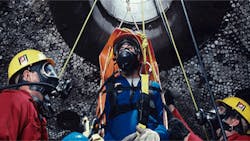Michaels: New Confined Space in Construction Standard ‘Only Makes Sense’
OSHA’s new standard, Confined Spaces in Construction, is the “culmination of decades of work by the agency,” said Assistant Secretary of Labor David Michaels in a press call on May 1, adding it was a major step toward ensuring that workers in different industries and occupational equally are protected from confined spaces.
“It only makes sense that all workers have the same protection when working around hazards,” said Michaels. “This new rule offers same level of protections [for construction workers as] workers in other industries who work around the same hazards.”
OSHA predicts the new rule will save the lives of five workers each year, and protect as many as 800 construction workers who must enter confined spaces each year.
There are differences between the confined space standard for construction and that of general industry, said Michaels.
"Unlike most general industry worksites, construction sites are continually evolving, with the number and characteristics of confined spaces changing as work progresses,” said Michaels. “This rule emphasizes training, continuous worksite evaluation and communication requirements to further protect workers’ safety and health.”
Stakeholder meetings on the standard started in 2000, in in 2007, the agency issued a notice of proposed rulemaking. The final standard substantially is different than what was released in 2007, said Michaels, crediting the input of many stakeholders for the content of the final standard, which will be published on May 3.
All provisions of the Confined Space in Construction standard take effect August 3.
Michaels was asked which employer on a construction site, when there might be dozens of contractors and subcontractors on site, would be responsible for compliance with the new requirements of the standard.
“All are responsible for meeting that requirements,” said Michaels. “The basic principle is that there must be shared information and active communication between all employers involved. Without that, it puts all employees at risk.”
About the Author

Sandy Smith
Sandy Smith is the former content director of EHS Today, and is currently the EHSQ content & community lead at Intelex Technologies Inc. She has written about occupational safety and health and environmental issues since 1990.
